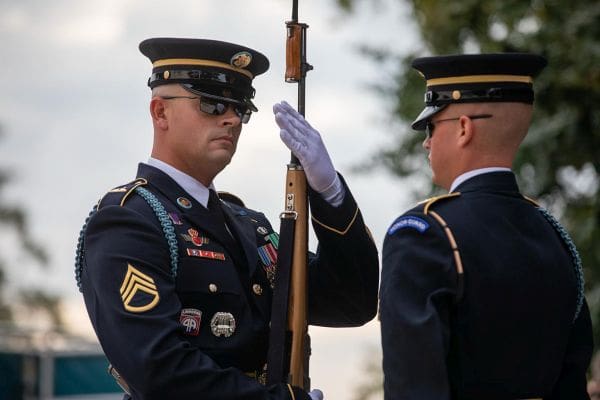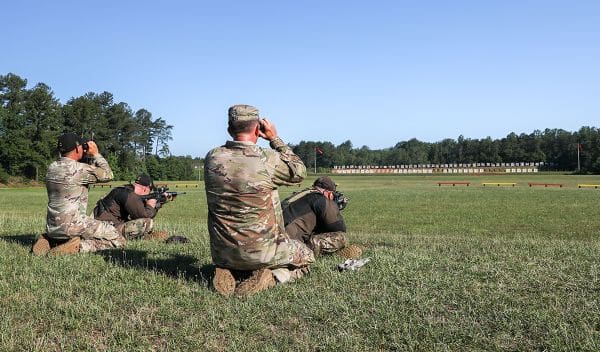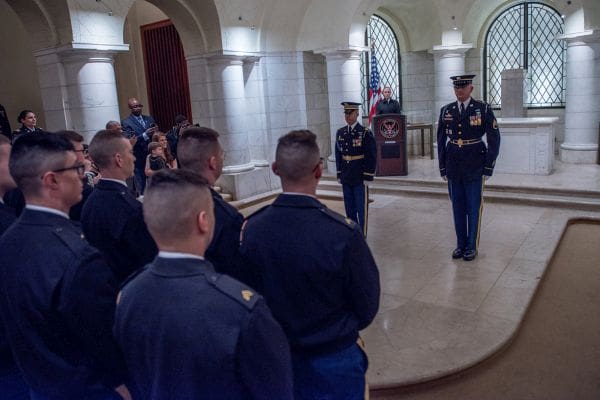Hunting and Fishing News & Blog Articles
USAMU’s Sgt. 1st Class Alexander Deal Reflects on His Time at the Tomb of the Unknown Soldier

Having now been in the U.S. Army for over a decade, Sgt. 1st Class Alexander Deal, 33, has gathered an abundance of profound experiences. Through initiative and discipline, his involvements have granted him the motivation to reach the highest levels of precision – forever aspiring to enhance his surroundings, including for those close to him.
“Understanding that every decision you make, even on a personal level, can have effects on the Soldiers around you – wanting to do better for yourself and wanting to do better for them,” he expressed about being in the military. “It seemed like a lifestyle I could get behind. I just really felt compelled to do it.”
After a trial run with the U.S. Army Marksmanship Unit (USAMU) Service Rifle Team at the Civilian Marksmanship Program’s 2021 National Matches at Camp Perry, Ohio, he officially joined the unique unit in November – ready to represent the United States through competition and educating others. He arrived at the USAMU from yet another elite unit that tested the strength of his spirit and was an honor very few will ever experience.
 Deal performed his final Tomb of the Unknown Soldier walk near the end of the summer in 2021. Photo Courtesy of the U.S. Army Old Guard
Deal performed his final Tomb of the Unknown Soldier walk near the end of the summer in 2021. Photo Courtesy of the U.S. Army Old GuardFor five years, Deal served at The Old Guard, 4th Battalion, 3d U.S. Infantry Regiment – two of those years spent at the Tomb of the Unknown Soldier. For six months, he was a Squad Leader/Relief Commander for one of the three reliefs that guard The Tomb. The following year and a half, he was the attending Assistant Sergeant of The Guard/Operations Non-Commissioned officer. His duties at the Tomb included administrative responsibilities within the organization such as training, logistics and supply.
“All of us Tomb Guards go down to the Tomb for different reasons,” Deal explained. “For me, the initial draw was I genuinely wanted to serve with the best Soldiers that my current unit had, and from what I had been told and what I had seen, that was the Tomb Guards down there at the Tomb of the Unknown Soldier.”
 “The Tomb is not just a place. It’s not just an object. It still has a lot of significance for people today.” Photo Courtesy of the U.S. Army Old Guard
“The Tomb is not just a place. It’s not just an object. It still has a lot of significance for people today.” Photo Courtesy of the U.S. Army Old GuardThe Tomb of the Unknown Solider is a 24-hour, 365-days-a-year guard post dedicated to memorializing the sacrifices of United States servicemen and women. Located at Arlington National Cemetery, near Washington D.C., the Tomb was established in 1921 when an unidentified servicemember from World War I was interned on Nov. 11 of that year. Marking its centennial in 2021, the Tomb is also the final resting place of two other American service Unknowns from later wars who were added in 1958 and 1984.
The Guards didn’t start serving at the Tomb until 1925, assuming the role recognized today in 1948. Guards can move on to become Sentinels after intense, rigorous training to earn the honor.
 Sgt. 1st Class Deal (center, sitting) joined the Army Marksmanship Unit in November 2021. Photo Courtesy of the U.S. Army Marksmanship Unit
Sgt. 1st Class Deal (center, sitting) joined the Army Marksmanship Unit in November 2021. Photo Courtesy of the U.S. Army Marksmanship UnitTraining to become a Sentinel is so difficult that since the Tomb’s creation, there have only been just under 700 fully qualified individuals. The Tomb Guard Identification Badge, which displays the words “Honor Guard,” is so highly regarded that it’s the only military award that can be revoked (even after military service) if an individual discredits or brings dishonor to the organization.
Deal earned his Tomb Guard Identification Badge #678 in just five months – a feat not accomplished by many. His duties as a Tomb Guard included conducting wreath ceremonies to honor the Unknowns and interacting with the crowds when he was able. Those moments brought some of the most memorable encounters during his time as a Guard.
 Sgt. 1st Class Deal has been involved with marksmanship since high school and will now teach others the skill through the AMU. Photo Courtesy of the U.S. Army Marksmanship Unit
Sgt. 1st Class Deal has been involved with marksmanship since high school and will now teach others the skill through the AMU. Photo Courtesy of the U.S. Army Marksmanship UnitOne memory he holds close is a particular family wreath ceremony where a young girl in the group happened to be wearing a unit crest from Deal’s exact parachute infantry regiment he had previously served with, the 508th. He asked her where she had gotten the crest, and she explained that they had just finished their grandfather’s funeral service in Arlington.
“That was definitely, for me, a very, very profound moment because I was very fond of my experiences in the 82nd – a lot of really good friends there, especially in the 508th. And then to meet somebody like that who had the kind of day that she had had, and to understand what it meant for them to not just be at Arlington but to be at the Tomb,” he said. “It’s the primary reason the Tomb was established, was to be a focal point for people to come and grieve.”
 Sgt. 1st Class Deal (right) was pinned with Tomb of the Unknown Soldier Identification Badge #678 on February 26, 2020. Photo courtesy of the U.S. Army, Sgt. Nicholas T. Holmes
Sgt. 1st Class Deal (right) was pinned with Tomb of the Unknown Soldier Identification Badge #678 on February 26, 2020. Photo courtesy of the U.S. Army, Sgt. Nicholas T. HolmesHe also says he had the same pride any time they were able to host an Honor Flight, where a state organization allows veterans of all wars the chance to take a tour of D.C.
“Sometimes you’ll see hundreds of these veterans from as far back as World War II coming and showing their respects. And without fail, you get to a point where taps is played . . . and you see all these veterans, oftentimes in wheelchairs and oftentimes some of them audibly fighting off their caretakers so they can stand to their feet, render a hand salute or place their hand over their heart – oftentimes tears in their eyes,” Deal recalled. “It shows you that the Tomb is not just a place. It’s not just an object. It still has a lot of significance for people today.”
 Deal was the first Tomb Guard to earn the President’s Hundred Tab as a top competitor in the President’s Match. Photo Courtesy of the U.S. Army Marksmanship Unit
Deal was the first Tomb Guard to earn the President’s Hundred Tab as a top competitor in the President’s Match. Photo Courtesy of the U.S. Army Marksmanship UnitAbout Sgt. 1st Class Deal:
Sgt. 1st Class Deal was born and raised in Columbus, Georgia, just outside of Fort Benning – the same spot where he now serves as a member of the USAMU. He was adopted and raised by his great-grandparents. His great-grandfather was a Korean War veteran, which helped lead Deal toward a military path.
“I was kind of always around it,” he said. “Obviously being just outside of Fort Benning, there’s a big military presence, so it was something I was exposed to from a very young age and something I was always interested in.”
His involvement in marksmanship began when he shot three-position air rifle in high school in the Muscogee County School District in Georgia for four years. When he was 18, he received a nomination and acceptance to West Point where he completed three years before enlisting into the Army in 2011.
He spent the next five years at Fort Bragg in North Carolina where he was deployed with the 82nd Airborne in 2013 and 2014. In 2016, he arrived on orders to Fort Myer where he was with the Old Guard 3d Infantry Regiment.
“It takes a lot of discipline and mental toughness to guard the Tomb of the Unknown Soldier for a 26-hour period,” he added. “It also takes a lot of mental toughness to take a 20-shot string at 600 yards with the wind blowing 20 miles an hour.”
Sgt. 1st Class Deal learned about the famous Camp Perry ranges, Distinguished Badges and other marksmanship honors after being involved with the All Army 82nd Airborne Post team. A few years later, he became interested in the USAMU and finally got the opportunity to experience the unit at the National Matches in the summer of 2021. There, he was an instructor in the Small Arms Firing School, as well as a competitor in the prestigious matches that can only be found at the annual event.
During the coveted National Matches President’s Rifle Match, Deal earned his President’s Hundred tab (a sought-after achievement for many marksmen) by placing 23rd out of nearly 840 competitors. He was also the first Tomb Guard in history to do so.
He’s constantly improving, moving from Staff Sgt. to Sgt. 1st Class in December 2021. Within his new role at the AMU, Deal admits the responsibility he enjoys most is training and coaching others on and off the range.
“You get out there and you get to talking. If nothing else, you share shooting in common, and we’ll talk about that – whether it be what the wind’s doing that day or different equipment setup, things like that, and just sharing experiences” Deal said. “I think that’s a very profound piece of the USAMU that I’ve really enjoyed, especially the Small Arms Firing School.”
More About the Tomb Guard:
The Tomb has been guarded every minute of every day since 1937. The first Sentinel badge was awarded in 1958 to Sgt. William Daniel. Since then, the Guard has retained five female Sentinels over its history – the first, Sgt. Heather Johnson, earned her Identification Badge in 1996, and the most recent, Sgt. 1st Class Chelsea Porterfield, earned hers in 2021.
A Tomb Guard (all collectively) or a Sentinel (those who have earned their badge) on average will spend about 107 hours a week on the job and preparing to do the job.
“To put it in perspective, if you understand how smart phones work these days, a lot of us have had our Google or Siri try to change our home location to the Tomb – that’s how much time is put into mission readiness there,” Deal joked.
Guards report earlier than the majority of the United States military and enter a 26-hour shift. The Tomb Guard Quarters includes a kitchen, bathroom, bunk areas and other resources, including the “Ready Room” where they prepare their uniforms (which can take an average of eight hours to complete).
Day and night, the Tomb Guards “walk the mat,” which is a literal mat the Guards pace at the Tomb plaza. They mark 21 steps to signify the 21-gun salute honor given to military and foreign dignitaries. The Guard is changed every 30 minutes during the summer (April to September) and every hour during the winter (October to March), as well as every two hours during the night hours when the cemetery is closed. Fifteen minutes prior to a change, the entire relief is notified and all other work stops.
While on the plaza, Guards aren’t permitted to acknowledge the spectators in attendance, but, while not walking the mat, they provide history briefs and tours where they’re able to interact with the public.
Once the job is done for the day, they immediately work on getting their uniform back to its level of expectation for the next workday, which follows a recovery day in between. During the night, they eat, shower, practice physical fitness and get sleep as they’re able.
Instead of being hidden away during training, the Guards are out in view of the public completing Guard changes and defending the Unknowns. Training to become qualified to be a Sentinel is a triple-volunteer process – for the Army, service at the 3d Infantry Regiment and for the Tomb. A three-week evaluation then begins to determine whether an individual is capable of being trained to the standard of the Guard.
Once accepted, training can take eight to nine months on average. Individuals go through a series of four tests – each harder than the last, including a 17-page education test that must be memorized, verbatim. The concluding badge test includes an evaluation on conducting a Guard change. Their uniforms must be pristine, with only two deficiencies allowed, which can be something as simple as a visible piece of lint.
“Obviously you can get to two deficiencies very easily,” Deal said.
The final step is a history brief on everything they’ve learned during their training.
“It’s a go, no-go event,” Deal said. “If they put out any incorrect information, it’s an automatic event failure.”
After the completion of training, they’ll continue to serve at the Tomb for at least a year.
Every item that the Tomb Guard is wearing, down to the rifle they carry, has been heavily modified or built from scratch for that individual. The stocks of the rifles are hand-sanded and stained by the Guard. The belts they wear are cut from a roll of belt material. The blouses are pressed and sewn. They’re also issued an American flag, identical to the flags used at Arlington. Some put significant dates or milestones on their flags as reminders of their experiences and the magnitude of the position.
“For me, personally, it’s always kind of in the back of the mind,” Deal said of the significance of being a Guard. “That’s all you’re really focused on, is making sure the mission’s done, the Soldiers are at their high state of readiness, they’re going out there at the highest level of proficiency possible every single Guard change.”
“The impact of what they’re doing and why they’re doing it is always there if you talk to any one of them,” he added of the Tomb Guards. “It’s never something that goes away.”
Learn more about the Tomb of the Unknown Soldier at https://tombguard.org.
Listen to the CMP Podcast, SFC Alexander Deal: Tomb Guard of the Unknown Soldier, by visiting https://thecmp.org/news-media/cmp-podcasts/.
The Civilian Marksmanship Program is a federally chartered 501 (c) (3) non-profit corporation. It is dedicated to firearm safety and marksmanship training and to the promotion of marksmanship competition for citizens of the United States. For more information about the CMP and its programs, log onto www.TheCMP.org.
The post USAMU’s Sgt. 1st Class Alexander Deal Reflects on His Time at the Tomb of the Unknown Soldier appeared first on Hunting and Hunting Gear Reviews.
Copyright
© Hunting and Hunting Gear Reviews
